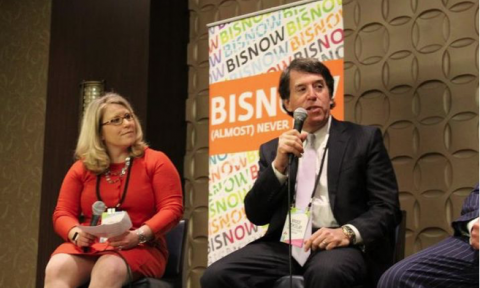Bisnow
September 5, 2019
Thousands of new hotel rooms are in Boston’s development pipeline, and experts expect them to drive down the city's occupancy for the foreseeable future.
Roughly 2,500 hotel rooms under construction in Boston and Cambridge are slated to open between now and 2021. That translates to a 10% increase in the two cities’ collective hotel supply, according to Pinnacle Advisory Group. An additional 5,600 rooms have either been approved or are in the planning phases.
Hotel demand is growing by 3% annually, according to Pinnacle Advisory Group principal Rachel Roginsky, who is speaking at Bisnow’s Boston Hotel Summit Sept. 19. But the two cities can’t maintain current performance levels of occupancy rates averaging 83% with all the new supply. Instead, Pinnacle Advisory expects long-term average occupancy rates to decrease to 78%.
While analysts and developers remain optimistic about Boston’s ongoing construction boom, the additional hotel supply delivering to market around when many analysts anticipate some degree of a national economic slowdown is concerning. “Supply is the big risk, because if ever we encounter a market slowdown, that’s going to hurt,” said The Mount Vernon Co. founder Bruce Percelay, who developed the Revolution Hotel in the South End. “Developers tend to make decisions when the sun shines and tend to deliver during thunderstorms.”
The Boston forecast follows a national trend of the U.S. hotel development pipeline outpacing demand, which leads to a decline in occupancy. Room rates are also increasing below the rate of inflation. But despite the expected slowdown on the horizon, Roginsky remains optimistic about the Boston-Cambridge hotel market.
Boston’s revenue per available room (or RevPAR, the key performance indicator for the hotel industry) was up 3.9% in 2018, above the 2.5% average of the top 25 U.S. markets tracked by STR. For the first half of 2019, Boston and Cambridge’s 1.8% RevPAR growth was still higher than the 1.2% U.S. average.
The new hotel product hitting the Boston market includes luxury hotels like the Four Seasons One Dalton and Raffles Boston Back Bay Hotel & Residences, which will break ground later this month. Economically priced properties that rely less on staff and more on technology, like Marriott's Moxy and the CitizenM Boston North Station hotel, are also new to Boston.
The Revolution Hotel, which opened late last year, offers smaller, modern rooms at rates roughly a third the price of nearby hotels in Back Bay. While Percelay expected millennial travelers to drive business, he said cost-conscious families and business travelers have been the hotel’s biggest client base. That keeps him optimistic for his own property’s performance.
“I think what needs to be analyzed from an occupancy standpoint is which categories are the new supply coming from: luxury, convention or entry-level,” Percelay said. “We’re servicing a part of the market that new supply doesn’t really satisfy because it’s too expensive.”
The variety of product underway makes Spot On Ventures principal Robin Brown, a co-developer of the Mandarin Oriental and Omni Boston Hotel at the Seaport, optimistic and less concerned with one data point like lower occupancy.
“At the end of the day, if some hotels can achieve 83% or 85% and some ‘suffer’ at 75% or 76%, so be it,” Brown said. “We’re still way up there as one of the top-performing hotel markets in the world.”
As with other asset classes, the hotel industry benefits from the region’s generally stable economy rooted in healthcare and higher education. Growth in the life science and technology sector have fueled rising room rates. But massive growth in recent years at Logan International has helped the contract side of business.
More international flights into Logan mean more airline crews require downtown lodging. Contract lodging makes up 5% of the market’s overall demand, according to Pinnacle Advisory’s 2020 forecast report. Hotels have been able to capitalize on that demand and increased contract rates from a $108/night average in 2012 to $187/night last year — a 45% increase in six years.
But the optimism still doesn’t get around lower occupancy expectations, especially in colder months.
“There’s not much movement to be had between April and October,” Brown said. “It’s the other months we worry about.”
Expanded ballroom and breakout room options at the Boston Convention and Exhibition Center could do the trick. The Omni Boston Hotel at the Seaport will have ballrooms of 16K SF and 26K SF, respectively, which will be the city’s largest. Advance bookings at the hotel, slated to open in late 2020, have been “quite extraordinary,” Brown said.
Existing conventions in Boston generate up to 600,000 hotel room nights annually, according to Pinnacle.
While Gov. Charlie Baker canceled a $1B plan to expand the BCEC in 2015, a study is currently underway to explore a new expansion plan that relies less on creating a massive trade room floor and more on ballrooms and breakout space. More ballrooms would enable the facility to host back-to-back events and reduce periods of slower nights between conventions at the Omni, Westin Boston Waterfront and other neighborhood hotels.
“Having the added space at the convention center to start and end conventions back-to-back and not have these graphs that keep spiking up and down is going to drive RevPAR,” Brown said. “If we can all acquire business that way, you can driver higher occupancy year-round.”
View Full Article Here

